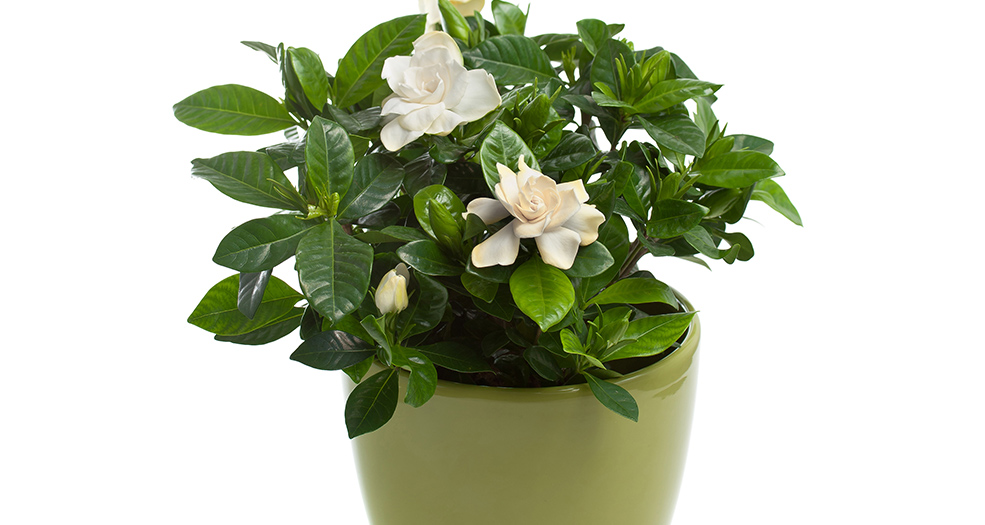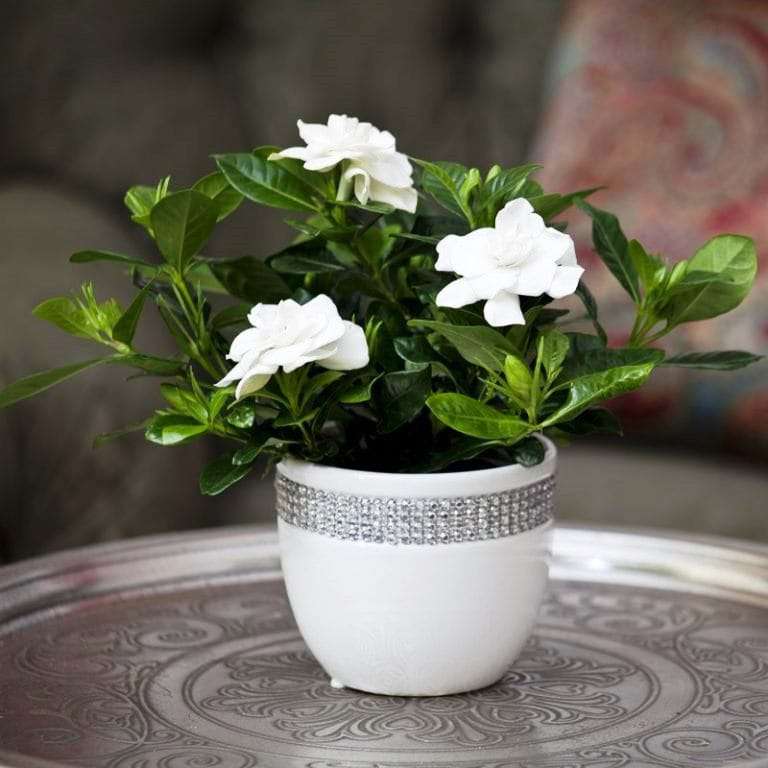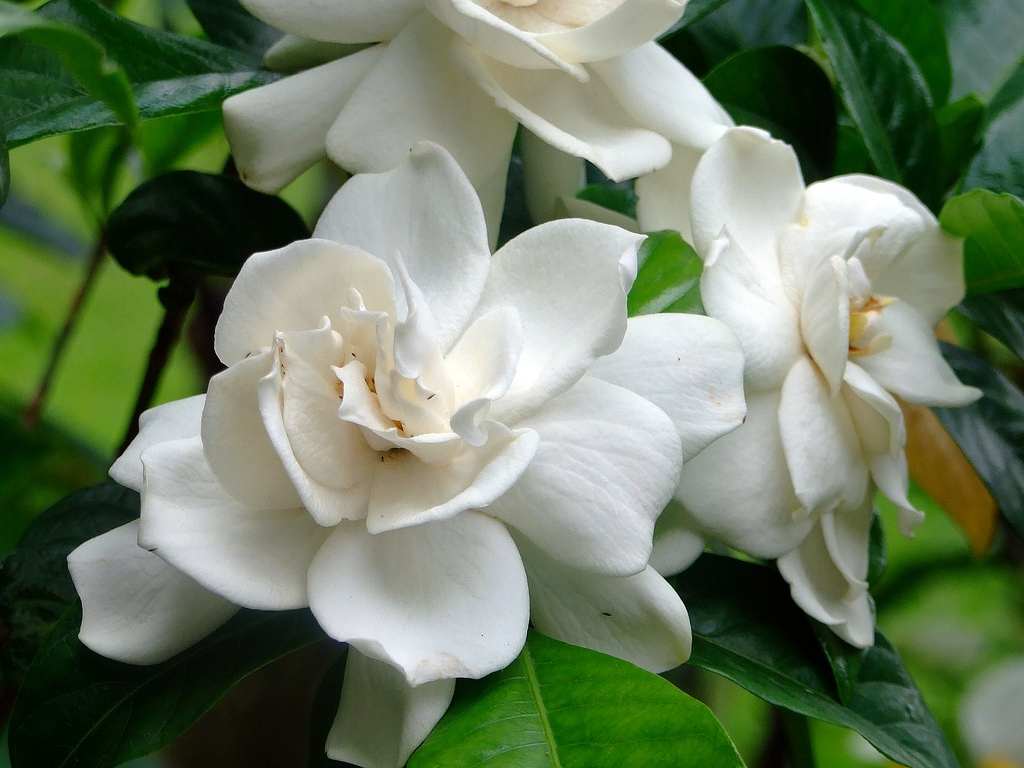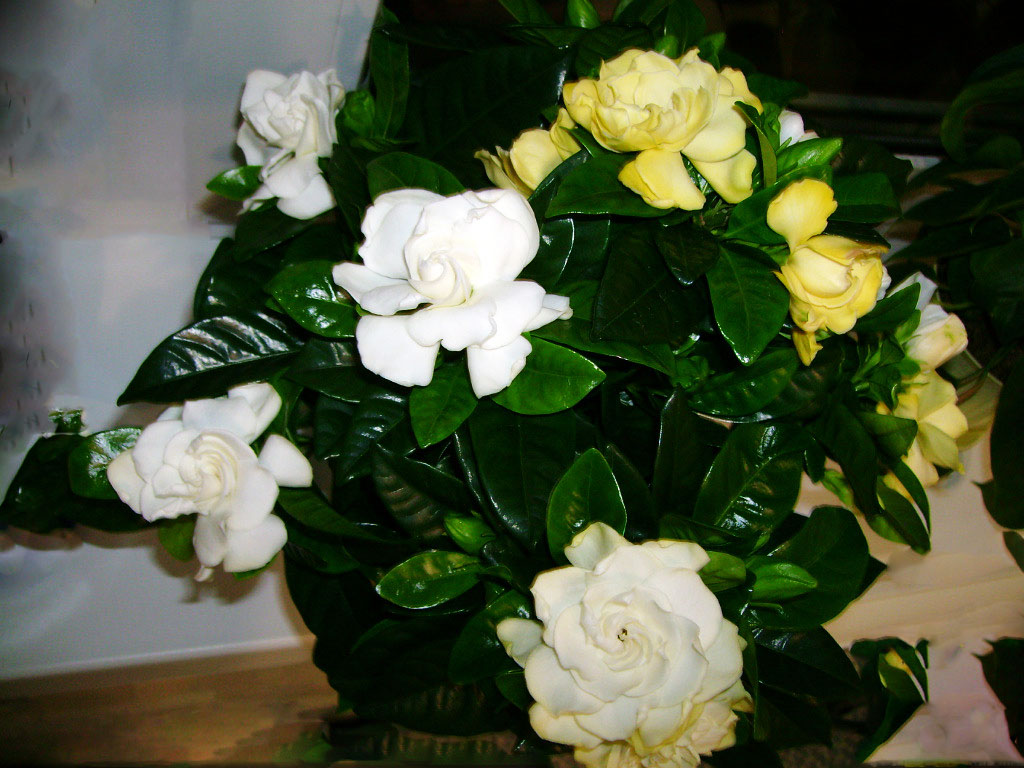Features of plant care
In order for the Vietnamese shrub to grow, develop and cover the entire apartment, you need to know what gardenia care should be at home.
Important! When growing gardenia jasmine, it is necessary to maintain air humidity and avoid sudden changes in temperature.
Temperature
If we take into account the history of the appearance of gardenia in Russia, then it follows that the plant loves warmth, but it should also be in moderation. In winter, the flower will feel comfortable at eighteen degrees, in summer the air should warm up by no more than 22 degrees Celsius.
Lighting
The flower prefers a lot of light, at the same time, direct sunlight is contraindicated for it, since they have a bad effect on the foliage, which will begin to turn yellow and become covered with brown spots. In the summertime, the gardenia pot is best placed in a shaded area.

Gardenia flowers reach up to 8 centimeters in diameter
In winter, the sunlight will no longer be so destructive, and the plant can be transferred.
Watering
In the period from spring to autumn, gardenia should be watered moderately, preventing the soil from drying out. In winter, a dormant period begins, so the plant already needs less moisture. Once every seven days, it is recommended to acidify the water for irrigation with lemon juice or acid.
Important! Knowing the rules of how to care for a gardenia, the florist will not allow the soil to dry out, as well as stagnant water, otherwise the roots will begin to rot
Spraying
Spraying is essential for gardenia. Only warm water is used for this procedure. In the process of spraying, care must be taken that the liquid does not fall on the flower petals.
Humidity
Air with moderate humidity is suitable for a flower. To create the necessary conditions, it is enough to place the pot on a pallet filled with expanded clay with a little water.
Priming
The most optimal for the growth and development of jasmine gardenia will be an acidic soil. Only under such conditions, the flower quickly assimilates nutrients. Therefore, regular acidification of the soil is necessary.
Note! To make the roots comfortable, you need to select soil for the gardenia, which has the ability to retain water and at the same time dry out quickly. You can create the necessary conditions by adding a little sand, perlite and sphagnum to it
Top dressing
Top dressing is recommended throughout the spring and summer in the first year of planting. For her, mineral fertilizers are used on an acidic basis with the addition of all the necessary trace elements. Throughout the life of a flower, it is recommended to spray with the addition of complex fertilizers.
In winter
In winter, when the plant is resting, it needs to create comfortable conditions. First of all, take care of the air temperature, which should be between 10 and 18 degrees. In this case, daylight hours should last at least 12 hours. You will need to use fluorescent lamps. The soil should always be slightly damp, but not wet or completely dry.
Pruning
Regardless of where the gardenia is grown, in the garden or indoors, it always remains a shrub. Therefore, the plant is characterized by such a procedure as pruning. It is not necessary to do it, since it is carried out rather in order to give the bush the necessary shape.
Prune the plant after the last flowers have bloomed. This period falls at the end of summer. In this case, you can remove half of the green mass of the flower.
3. Varieties:
3.1 Gardenia jasmine or regal - Gardenia Jasminoides
Evergreen shrub 1.5 to 2 m in height with abundantly branching, erect stems.Leaves are dark green, up to 10 cm long, thick, glossy, entire, lanceolate. The leaf blades are covered with a network of branched veins. The leaf petioles are short. The flowers are large - they reach 8 cm in diameter, resemble a rose, emit a very intense aroma reminiscent of jasmine. Flowering occurs from May to July.

3.2.Gardenia Tahitian - Gardenia taitensis
Tall, multi-stemmed shrub, reaching 4 meters in height. Leaves are lanceolate, entire, dark green, arranged in opposite pairs. In length, the leaves reach 15 - 16 cm. Leaf veins are often highlighted with a lighter shade. Shoots are thin, flexible, branching abundantly. The flowers are light - white or cream, up to 9 cm in diameter, have a sweetish aroma.

3.3.Gardenia Vietnamese - Gardenia vietnamensis
Fast-growing, evergreen, multi-stemmed shrubs with thin shoots up to 1 m high. Leaves are oblong lanceolate, dark green, whole-edged. The flowers are creamy, single, with narrow, long petals, have a sweetish aroma, which intensifies in the evening and night hours.

3.4.Gardenia Thunberg - Gardenia thunbergia
Multi-stemmed, dense, evergreen, large-flowered shrub or small flowering tree from 1.5 to 4.5 m high. Leaves are oblong - oval, lanceolate, glossy, dark green, collected in whorls of 3 - 4. The flowers are spectacular, creamy, large reach a diameter of 8 cm. During the flowering period, the shrub emits a pleasant aroma, which is especially enhanced at night and in the evening.

3.5 Gardenia Nitida - Gardenia Nitida
Evergreen, multi-stemmed shrub up to 2 m high. Leaves are glossy, whole-edged, 8 to 18 cm long and 4 to 6 cm wide. The flowers are white, fragrant, up to 8 cm in diameter. The flower petals are often drooping. The sweetish aroma is felt at a great distance from the bush in the evening and at night.

You may also be interested in:
Hydrangea
Begonia
Hyacinth
Hibiscus
How to save a plant from diseases and pests
Gardenia is prone to various diseases, a capricious plant with any violation of care can get chlorosis, coal mold and other diseases.
Table: why diseases appear and how to reanimate a plant
| Diseases and pests | Signs | Reason for appearance | Treatment and prevention measures |
| Chlorosis | The leaves turn pale, yellow streaks appear on them. If chlorosis is left untreated, the plant may die. | lack of iron |
|
| Charcoal mold | The leaves begin to darken. Affected leaves may fall off. | lack of light and poor air circulation |
|
| Mealybug | White lumps appear on the leaves, similar to cotton wool. | excessive dampness |
|
| Thrips | Grayish-white dots form on the leaf blades. | excessive dryness of the air | Treat the gardenia with insecticidal soap or Decis (according to the instructions). |
| Shield | Brown bumps and sticky discharge form on the leaf blades. The leaves become paler in color. | insufficient humidity in the room |
|
| Whitefly | Greenish larvae cover the underside of the leaves.Severely affected leaf blades turn yellow and fall off. | over-watering |
|
| Spider mite | The visible mark of a tick is a thin cobweb on a plant. Insects suck the sap from the leaves. If measures are not taken in time, the leaves can wither, turn black and eventually dry out. | too dry air |
|
How do you recognize you, gardenia jasmine?
At home, an adult bush can grow from 50 to 180 cm tall. It has strong woody shoots with shiny leaves and fragrant large flowers. Gardenia blooms in nature twice a year. In culture, large-flowered forms with a long flowering period have been bred.
However, it is not easy to grow and wait for the flowering of a capricious beauty. It is difficult to create the desired microclimate and maintain it unchanged at home. The slightest deviation in the care of gardenia jasmine responds by changing the color of the leaves, fading, dropping flowers and cover. Read about the coin loosestrife!
Even prolonged bad weather can spoil the mood of a tropical guest. Lack of light leads to plant fading
It is important to arrange for the sissy backlight to relieve stress. Moreover, now there are special additional lighting lamps
Plant does not tolerate:
- prolonged exposure to direct midday sunlight;
- dry air;
- improper watering and nutrition;
- uncomfortable temperature.
Flowering occurs at the tips of the shoots and axillary, closer to the light. Therefore, the annual pruning of lignified twigs allows you to make the bush decorative and provides planting material for propagation - cuttings.
On this topic:
In the caring hands of a skilled mistress, jasmine gardenia, a photo, will delight with a radiant look and an exquisite aroma of flowers. The scent is strong and there is no place for a flower in the bedroom.
Growing gardenia from seeds

Gardenia seeds photo
Large gardenia seeds can be planted without problems one at a time in separate cups, so as not to engage in picking later. But many growers prefer to sow in a common container in order to take up less space in the first month of growing. Everyone chooses what is most convenient for him.
- The seeding depth is 1 cm, the distance between seedlings is 2-3 cm.
- The sown seeds are sprayed with a spray gun and covered with foil.
- In such a mini greenhouse, the plants will sprout within three weeks.
- Care consists in maintaining constant soil moisture (there must be drainage, which excludes stagnant water) and regular ventilation of the greenhouse.

Gardenia from seed photos of seedlings
- If the sowing was carried out in a common container, at the stage of 3-4 true leaves, the plants dive into separate containers, pinching the central root, they are still covered with bags or transparent jars.
- 7-10 days after the transplant, feeding with a complex preparation for azaleas is carried out.
When the seedlings grow up, they are gradually accustomed to open space, removing the shelter.
Description and origin of the jasmine variety
During the flowering period (March-October), the bright green background of the foliage is contrastingly complemented by pale cream flowers (there are all kinds of shades - yellow, pink, vanilla). The size of the flowers is 6-8 cm in diameter. They are located singly or in small groups in the form of corymbose inflorescences.
As you can see in the photo, the flowers look like a peony or a rose. Delivers a delicate jasmine scent. The natural habitat for the growth of the Jasmine gardenia is the African subtropics, China and Japan.
Of the wide variety of varieties, the following can be distinguished:
- Beauty. This variety with a height of 1.5-2 m is characterized by a very rich flowering. The flowers are white, double, large.
-
Chuck Hayes. It became famous for its fragrant semi-double flowers of the "ivory" shade and good winter hardiness.Height - up to 2 m.
- Belmont. This variety stands out from a number of others with rounded leaves up to 10 cm in size, dense double flowers, good resistance to diseases and low temperatures.
-
Amy. Able to bloom 2 times a year with luxurious double flowers up to 12 cm in diameter. The leaves are dark green.
- Variegata. Features - variegated leaves, medium-sized flowers and a slow growth rate (very convenient to grow in a pot).
- Golden Magic. It blooms for a long time, and the flowers suddenly change from white to golden yellow.
It will also be interesting: Clerodendrum Filipino - caring for a plant at home?
Types and varieties
Gardenia jasmine (aka Gardenia Augusta, regal, Cape jasmine) is an evergreen shrub that grows up to two meters in natural conditions, and at home - no more than 80 cm.The leaves are shiny, saturated dark green, pointed to the base. Flowers grow on the tops of the shoots one at a time or are collected in groups of three or more pieces. Flowering occurs in summer and autumn.

Varieties:
Gardenia "Chuck Hayes" - a variety reaching up to two meters in height, semi-double flowers, fragrant, the color of baked milk. They begin to bloom at the threshold of summer, and continue to appear throughout the season. The variety has good frost resistance.

Gardenia "Belmont" - has rather large rounded leaves. Terry flowers (10 cm in diameter), with a rich pleasant aroma. A variety resistant to diseases and cold snaps.

Gardenia "Amy" (Aimee) - Gardenia has lighter foliage than the rest. Double flowers (up to 12 cm) seem to be artificial due to their ideal shape. It blooms twice a year.

Gardenia "Mystery" is a very popular variety, reaching a height of 1.5-2 meters, with large dark green leaves. Terry flowers are flat (up to 13 cm). The flowering process can be observed twice a year. It is characterized by vertical growth.
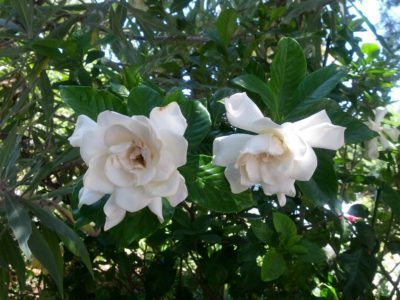
Gardenia "Radicans"
A dwarf, very compact and pretty bush, no more than one meter in height and a little more than a meter in width. It has small glossy leaves. Terry flowers are also not large (2-5 cm). This variety is used as a "bonsai".

Gardenia Variegata is a good pot plant as it grows slowly. Leaves are variegated, rounded, with regard to color, various smooth transitions from green to cream are noticed. Fragrant inflorescences (up to 8 cm in size).

Gardenia "Radican Variegata" is a dwarf variety (up to 1 m) with variegated leaves. Slow growth is observed. Dark green leaves with a characteristic cream-like rim stripe. Flowers from 2.5 to 5 cm in diameter - bloom late. Bonsai variety.

Gardenia "Golden Magic" - differs from others in the length of the flowering period (longer than others). A rapid transition from white to golden corolla is noted.

Gardenia Thunberg
An evergreen tropical shrub that can also grow into a small tree with fragrant flowering belongs to the Madder family (magnolia and coffee tree are considered related). In nature, it can be found in South Africa. Large, smooth dark green leaves, located on short processes emerging from a straight woody stem. The fan-shaped white flowers (about 8 cm in diameter) have a bright aroma, which intensifies in the evening.

Gardenia Tahitian is a large shrub (about 3 m tall). The surface of the leaves is glossy, oval and dark green in color. You can distinguish it by the flowers (about 8 cm in diameter), in which the petals (there are up to 8 pieces) seem to bend to the side along the trajectory, resembling the blades of a propeller.

Gardenia keeled (yellow) is a large, rounded shrub or tree (3 m tall). Shiny oval-shaped leaves, not as rich in green as other species, have unusual lateral veins.Large yellow flowers have an extension at the end and, as it were, overlapping petals. Very pleasant aroma.

Gardenia brigama is a small tree. Leaves are shiny, oval, dark green. A distinctive feature is precisely the inflorescences - these are single snow-white flowers, consisting of six petals, twisted in a very unusual way (and the ends are slightly bent), resemble the blades of a fan (or other machines).

How do I get grains?
Growing an exotic shrub from seeds is a difficult and time-consuming procedure. Fresh and quality seed is one of the success factors.
Gardenia bloom age - 5 years, sometimes with good care, it blooms earlier. Fragrant petals open in July and delight the eye until September. After flowering the buds, dry seed pods appear.
The diameter of the seed is 4-5 mm, it looks like a lemon in shape. One tip is sharp, and the other is blunt, the surface is ribbed. The color of the seeds is light and dark brown.
If you buy seeds from flower growers, then you should consider them, they should be whole, without damage and signs of decay. When purchasing material in a specialized store, one can only hope for luck. There are times when 1-2 seeds emerge from 5 seeds put in a bag.
Brief description of the plant
Wild gardenia perennials are found in abundance in the subtropical forests of Japan and China, which are their natural environment. Today, taking into account the contribution of breeders, botanists have about 250 plant species.
Among them, gardenias are popular in floriculture:
-
jasmine;
-
citriodora;
-
Vietnamese;
-
Tahitian.
Outwardly, gardenia is an evergreen shrub with lignified densely pubescent or bare shoots, oppositely located dark green foliage and white or pale yellow buds.
In its range, the jasmine variety can grow up to two meters in height, and in indoor conditions it barely reaches half a meter. Waxy white buds and dense glossy foliage that bloom for several months give the culture a decorative effect. Large double flowers appear densely on the branches in July and wither in late autumn. Their peculiarity lies not only in the shape resembling a rose, but also in a pronounced pleasant aroma. It is recognized by many in perfumery products, cosmetic oils and care products.
Did you know? The Japanese idolize gardenia as a symbol of secret love, while the Chinese have flower buds representing the 11th month of the calendar. They see in him a feminine grace, fragility inherent in aristocratic natures.
Necessary conditions for keeping gardenia

Jasmine gardenia is an adornment of any room and interior. She creates coziness in the apartment with her unique grace. Among all the species of this plant, it is the most unpretentious. This mini-tree will be able to give its beauty only under certain conditions of keeping. For gardenia to be the accent of your home for a long time, follow the basic rules for caring for it:
- The flower does not tolerate sudden temperature changes.
- The plant always needs moderately moist soil. Underfilling and excess moisture are unacceptable.
- The ideal growing soil is acidic.
- The plant should be in a well-lit area, but not in direct sunlight.
- Grows well in high humidity conditions.
- At the stage of bud formation and during the flowering period, you cannot change the growing place or even turn the flower, as the buds can crumble.
- The plant loves a warm climate, the best temperature conditions for it are 20 degrees Celsius (plus or minus 2 degrees).
- Watering should be carried out only with purified, settled or rainwater and always warm water.
How to care for your gardenia at home

Gardenia jasmine indoor home care photo of flowering
Lighting
The optimal location will be south and west windows. In the summer, in the very heat, the plant is moved away from the window, making the rays scattered, in winter, on the contrary, they are brought closer so that there is enough light
It is important not to let the sultry scorching sun hit so as not to cause burns or leaf fall
Air temperature and humidity
The life cycle of a plant in natural conditions dictates its own rules for maintaining the air temperature over the seasons. In summer, temperatures are allowed up to 21-24 ° C during the day, at night up to 15-18 ° C. In winter, it can drop to 16 ° C, the minimum allowable air cooling is 10 ° C.
- Keeping cool in summer is difficult, but with the advent of air conditioning, the task has become easier.
- If you ventilate the room by opening a window, move the flower away from the cold air currents. Getting into a draft is fraught with the fall of flower buds and flowers, as well as newly formed flower buds. A similar effect is possible with a lack of moisture, dry air with a low oxygen content.
- It is advisable to regularly spray the plant over the leaves from a finely dispersed spray gun.
- The beauty loves humid air, help the plant: put the pot on a tray with moistened pebbles or expanded clay. Be sure to make sure that the water does not touch the bottom of the pot.
- In addition to regularly spraying on the leaves, wiping the leaves with a damp cloth is helpful. Removing dust, you contribute to the complete assimilation of oxygen from the air, full-fledged processes of air exchange and photosynthesis in the leaves.
The flower will have a healthy appearance, rich color and will never get sick with careful attention. A warm shower has a beneficial effect on the state of the plant, however, the soil in the pot should be covered with a package so as not to overmoisten it.
How to water
For irrigation, use settled water at room temperature. It's great if the water is filtered or melted, rainwater.
- In the spring and summer, keep the soil moist, avoiding the accumulation of moisture in the pot pan. Proper watering helps maintain the vigor of the plant in preparation for flowering and immediately during it.
- In winter, the growth of the flower slows down, the need for moisture decreases - reduce watering. Remember: if the soil is waterlogged, you risk losing the flower due to root rot, which can spread to the entire plant.
Gardenias like acidified soil, so citric acid must be added to the water for irrigation: a couple of grams per 1 liter of warm, settled water, which promotes the absorption of nutrients from the soil. Alternate watering with plain water and acidified water about three times for the fourth.
Top dressing
- Gardenia is fed twice a month with complex fertilizers for azaleas or ornamental flowering plants, following the manufacturer's recommendations.
- The flower responds well to foliar feeding with iron-containing preparations and magnesium sulfate, which can be carried out weekly. Such procedures can be continued even in winter, especially if you notice lightening of the leaves (chlorosis).
When does gardenia bloom?
The plant blooms from July to October, releasing new flowers every week. To maintain decorativeness and stimulate flowering, it is recommended to cut withered buds.
Varietal variety
Several dozen varieties of tropical plants have been bred. The varieties listed below are the most widespread.
Radikan Variegata
A dwarf variety with dark green foliage decorated with a cream border. The diameter of the flowers is from 3 to 5 cm.
Advantages and disadvantages
ideal for bonsai;
compactness;
decorativeness of leaves.
slow growth;
the appearance of flowers only for a short period of time in the summer.
I like not like
Beauty
Popular tall variety. The flowers are large, white, with double petals.
Advantages and disadvantages
high decorativeness;
abundance of flowering;
the appearance of flowers from early summer to late autumn.
I like not like
Chuck Hayes
The tall plant resembles a rose bush. The flowers are light beige, with a slight doubleness.
Advantages and disadvantages
intense aroma;
the possibility of garden cultivation;
cold resistance.
The only negative is the abundant flowering is short, only at the beginning of summer. Although individual buds may appear until the end of the warm season.
I like not like
Fortune
Variety with large flowers, white with a cream shade.
Advantages and disadvantages
non-capricious care in relation to other varieties.
the appearance of a specific peppery smell when spraying the leaves with water.
I like not like
Tahitian
A large variety with white flowers reaching 20 cm in diameter. The petals are smooth, propeller-shaped.
Advantages and disadvantages
high decorativeness;
delicious aroma;
flowering duration.
unpredictability of flowering. Buds appear only under favorable conditions, and when this will happen, it is impossible to predict.
I like not like
Kula
Large variety with golden flowers. The smooth petals are folded like a propeller.
Advantages and disadvantages
flowering brightness;
the possibility of garden cultivation.
slow growth.
I like not like
Veitchii
A variety of jasmine gardenia with large white flowers. One of the most popular among plant breeders.
Advantages and disadvantages
intense aroma;
long flowering (until the end of December).
I like not like
Fortuniana
A variety with large flowers resembling a camellia. Slight doubleness is characteristic.
Advantages and disadvantages
large flower diameter - up to 10 cm;
delicate aroma.
I like not like
First love
A variety of jasmine gardenia with light cream flowers. Terry petals.
Advantages and disadvantages
large diameter of opened buds - up to 12 cm;
exquisite aroma;
flowering duration - all spring until the end of summer;
the possibility of blooming twice a year.
I like not like
Kleims hardy
Small variety with white flowers. The petals are smooth, waxy.
Advantages and disadvantages
long flowering - from spring to late summer;
intense aroma.
I like not like
White Gem
A small variety, the bush grows up to 60 cm. The flowers are small, with smooth petals, like stars.
Advantages and disadvantages
compactness;
pleasant vanilla aroma.
I like not like
Four seasons
Low-growing variety. The flowers are light beige. A slight doubleness is characteristic.
Advantages and disadvantages
year-round flowering;
compactness;
resistance to temperature drops down to -5 ° C.
I like not like
Mystery
A sturdy, tall plant with large leaves and double-flattened flowers.
Advantages and disadvantages
large flower diameter - up to 13 cm;
flowering duration;
bloom twice a year.
An insignificant disadvantage is the tendency to vertical formation of shoots.
I like not like




